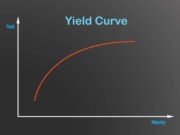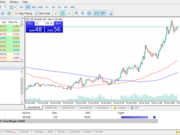Definition
The price/earnings ratio is the ratio of a company’s stock price to the company’s earnings per share. The ratio is used in valuing companies.
Price Earnings Ratio
The P/E Ratio is the calculation for valuing a company. It measures the current share price relative to the per-share earnings, also known as the price multiple or earnings multiple.
Calculation: Market Value per Share divided by Earnings per Share
Example: a company is currently trading at $43 a share with earnings over the last 12 months at $1.95 per share. The P/E ratio can be calculated as 43/1.95 = 22.05.
The EPS (Earnings per Share) is most often calculated from the previous twelve months. This is called trailing P/E, calculated by subtracting a company’s share value at the beginning of the 12-month period from its end value, keeping stock splits in consideration. Sometimes it can also be taken from analysts estimates, called projected or forward P/E. Thirdly, the sum of the last two actual quarters and the estimates of the next two quarters can be calculated, but this calculation is less popular.
The P/E ratio basically indicates the dollar amount an investor needs to invest in a company to receive one dollar of that company’s earnings. This is why it is also called the multiple, showing how much investors are willing to invest. For instance, if a company currently trades at a P/E of 20, the deduction is that an investor is willing to pay $20 for $1 of current earnings.
Usually a high P/E suggests that investors are expecting higher future returns.In contrast, a low P/E indicates that either a company may currently be undervalued or that it’s doing remarkably well relative to its past trends. With no earnings or losses, the company P/E will be expressed as “N/A.”
It is also a means of regulating the value of one dollar of earnings throughout the stock market. In theory the median of P/E ratios over a period of several years, could formulate into a standardized P/E ratio. This could then be seen as a benchmark for companies and used to indicate whether or not stock is worth buying.
The P/E Ratio has a few important limitations to keep in mind. Investors want to believe there is one single metric that will provide complete investment decision insight, but this is usually not possible.
Comparing the P/E ratios of different companies, is problematic. The valuations and growth rates of companies vary drastically between sectors. Thus, the P/E ratio should only be used as comparative tool when considering companies within the same sector.
Furthermore, a company’s debt can affect both the prices of shares and the company’s earnings. Another important limitation is the formula itself. Accurate, unbiased presentations rely on accurate inputs of market share value and earnings per share estimates.
Things to Remember
- Usually a high P/E ratio means that investors anticipate higher future growth.
- The average P/E ratio is roughly 20-25 times the earnings.
- The calculation formula can also be used to estimate a forward looking P/E ratio.
- Companies losing money don’t have a P/E ratio.
Further Reading
- Accounting measurement, price-earnings ratio, and the information content of security prices – www.jstor.org [PDF]
- What determines price-earnings ratios? – www.tandfonline.com [PDF]
- Survey and market‐based evidence of industry‐dependence in analysts' preferences between the dividend yield and price‐earnings ratio valuation models – onlinelibrary.wiley.com [PDF]
- An Empirical Study of A-share Stock Market's Initial Returns with No Limitation of IPO/s P/E Ratio – en.cnki.com.cn [PDF]
- Industry relative price-earnings ratios as indicators of investment returns – www.tandfonline.com [PDF]
- The interaction of firm size and price-earnings ratio on portfolio performance – www.tandfonline.com [PDF]
- LOW PRICE, PRICE‐EARNINGS RATIO, MARKET VALUE, AND ABNORMAL STOCK RETURNS – onlinelibrary.wiley.com [PDF]
- Accounting methods and P/E ratios – www.tandfonline.com [PDF]


































